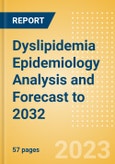Dyslipidemia is a medical condition characterized by the imbalance of lipids such as cholesterol, low-density lipoprotein cholesterol (LDL-C), triglycerides (TGs), and high-density lipoprotein (HDL) in the blood. Dyslipidemia is a major risk factor for the development of cardiovascular disease, including heart attack and stroke. Lipids, such as cholesterol or TGs, are absorbed from the intestines and are carried throughout the body via lipoproteins for energy, steroid production, or bile acid formation. Major contributors to these pathways are cholesterol, LDL-C, TGs, and HDL. An imbalance of any of these factors, either from organic or nonorganic causes, can lead to dyslipidemia (Rader, Hoeg and Bryan, 1994).
Dyslipidemia is classified into primary and secondary types (Pappan and Rehman, 2023). Dyslipidemia can be diagnosed by simple blood tests, such as a complete lipid profile, which is determined by the level of total cholesterol, TGs, LDL-C, and HDL cholesterol (HDL-C). Lipid measurement should be accompanied by an assessment for other cardiovascular risk factors, including smoking, diabetes mellitus, family history of coronary artery disease (CAD), and hypertension. Secondary dyslipidemia can often be managed through lifestyle changes, such as following a healthy diet, getting regular exercise, and maintaining a balanced body weight. In some cases, medication may be necessary to treat abnormal lipid levels.
In the 7MM, total prevalent cases of dyslipidemia are expected to increase from 287,608,383 cases in 2022 to 303,637,982 cases in 2032, at an annual growth rate (AGR) of 0.56%. In 2032, the US will have the highest number of total prevalent cases of dyslipidemia in the 7MM with 143,549,647 cases, whereas Italy will have the fewest total prevalent cases of dyslipidemia with 21,338,869 cases.
Dyslipidemia is classified into primary and secondary types (Pappan and Rehman, 2023). Dyslipidemia can be diagnosed by simple blood tests, such as a complete lipid profile, which is determined by the level of total cholesterol, TGs, LDL-C, and HDL cholesterol (HDL-C). Lipid measurement should be accompanied by an assessment for other cardiovascular risk factors, including smoking, diabetes mellitus, family history of coronary artery disease (CAD), and hypertension. Secondary dyslipidemia can often be managed through lifestyle changes, such as following a healthy diet, getting regular exercise, and maintaining a balanced body weight. In some cases, medication may be necessary to treat abnormal lipid levels.
In the 7MM, total prevalent cases of dyslipidemia are expected to increase from 287,608,383 cases in 2022 to 303,637,982 cases in 2032, at an annual growth rate (AGR) of 0.56%. In 2032, the US will have the highest number of total prevalent cases of dyslipidemia in the 7MM with 143,549,647 cases, whereas Italy will have the fewest total prevalent cases of dyslipidemia with 21,338,869 cases.
Scope
- This report provides an overview of the risk factors, comorbidities, and the global and historical trends for dyslipidemia in the seven major markets (7MM: US, France, Germany, Italy, Spain, UK, and Japan). It includes a 10-year epidemiological forecast for the total and diagnosed prevalent cases of dyslipidemia segmented by age (20-29 years, 30-39 years, 40-49 years, 50-59 years, 60-69 years, 70-79 years, and 80 years and older) and sex in these markets. Additionally, the report provides the total prevalent cases of increased LDL-C, high TGs, very high TGs, and low HDL-C segmented by age (20-29 years, 30-39 years, 40-49 years, 50-59 years, 60-69 years, 70-79 years, and 80 years and older) and sex in these markets. The report also provides a 10-year epidemiological forecast of the total prevalent cases of familial hypercholesterolemia (FH) in these markets.
The Dyslipidemia epidemiology series will allow you to:
- Develop business strategies by understanding the trends shaping and driving the global UC market.
- Quantify patient populations in the global Dyslipidemia market to improve product design, pricing, and launch plans.
- Organize sales and marketing efforts by identifying the age groups that present the best opportunities for Dyslipidemia therapeutics in each of the markets covered.
Table of Contents
1 Dyslipidemia: Executive Summary
2 Epidemiology
3 Appendix
List of Tables
List of Figures








